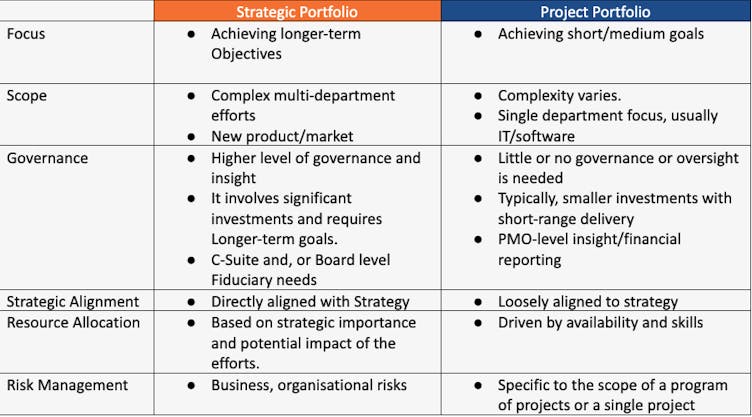Strategic Portfolio
A strategic portfolio is a collection of initiatives aligned with an organisation's overall strategy (sometimes called a Business Development Portfolio). It is a high-level view of the initiatives that the organisation is pursuing to reach its goals. Strategic portfolios typically include a mix of projects and programs designed to support the organisation's mission and vision and align with the company's strategic or annual planning cadences for funding and fiduciary management.
The focus of a strategic portfolio is on achieving the organisation's goals. The initiatives, projects, and investments aim to foster growth, increase revenue, and expand a company's market presence. It is a strategic tool that aligns an organisation's goals with the resources and activities necessary to achieve them. In essence, it's a blueprint for growth and innovation. Examples of initiatives in a strategic portfolio may include developing new products or services, entering new or expanding existing markets, or deepening the organisation's existing capabilities.
Project portfolio
On the other hand, a project portfolio is a collection of individual projects an organisation is undertaking. It is a more granular view of the work that is in progress to achieve the portfolio's goals. A project portfolio typically includes a range of projects that vary in size and complexity executed by different teams within the organisation.
The focus of a project portfolio is on short to medium-term objectives. The projects included in a project portfolio are typically more focused and defined as a 'slice' of the business, such as software development, marketing campaigns, or process improvement initiatives.
Key differences between Strategic Portfolios and Project Portfolios:

Why do these differences matter?
Understanding the differences between strategic portfolios and project portfolios is important for several reasons.
In the fast-paced and competitive landscape of today's business environment, establishing a strategic business development portfolio is an imperative step for organisations seeking to not only survive but thrive and grow. This pivotal framework sets the stage for strategic alignment, efficient resource allocation, and the continuous evaluation of performance. With expert portfolio management, organisations can unlock the immense potential of their business development initiatives and position themselves for resounding and sustained success. Get ready to seize the reins of your organisation's future and embark on a journey towards unparalleled growth and prosperity—the time to harness your full potential.
For organisations, a clear understanding of their strategic portfolio can ensure that they invest in initiatives aligning with their overall strategy and will help them achieve their long-term goals. Similarly, understanding their project portfolio can help them manage individual projects more effectively and ensure they deliver value to the organisation.
For project managers and team members, understanding the differences between the two types of portfolios can help them understand the bigger picture of the work they are doing and how it fits into the organisation's overall strategy; this can help them stay motivated and focused on the goals of the organisation, even as they work on projects.
In conclusion
While strategic and project portfolios may sound similar, the two have some key differences. Understanding these differences can help organisations and project teams work more effectively and achieve their goals more efficiently.
Look out for the next blog in this agile portfolio series, where we'll discuss key differentiators, metrics and tools to help you maximise value and insights across your portfolio!








